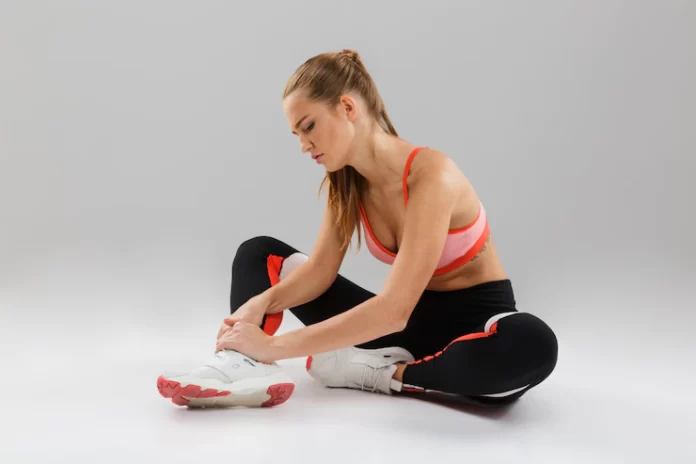At some point in their lives, the vast majority of people will suffer from pain in their feet or ankles. It is one of the busiest and most intricate parts of your body. There are a total of 26 bones and 33 small joints in it, all connected by a web of soft tissue that includes muscles, tendons, ligaments, nerves, and blood vessels.
Mild sprains and strains are the most common causes of temporary foot and ankle pain. Self-care measures should aid in the gradual healing of these. However, you probably won’t need medical attention unless your symptoms persist for longer than a month.
However, some types of pain have no discernible origin and may not respond well to self-care. Foot and ankle pain that worsens, doesn’t go away, or persists for more than a few months may be the result of structural changes or an underlying condition.
When My Feet or Ankles Start Hurting, What Should I Do?
Most cases of the foot or ankle pain are easily remedied without medical attention. Over the first few days, you should notice an improvement in your soft-tissue injury if you follow some basic self-care instructions. It could take months for the injured area to heal completely, during which time you should take extra precautions to avoid further injury.
Self-Care Advice
RICE pain relief is especially effective in the first two to three days after injury.
Rest:
To avoid putting any pressure on the injured foot or ankle. Avoid strenuous activity and, instead, try gently moving the area at regular intervals to prevent stiffness.
Ice:
Apply ice for 20 minutes at a time every 2 to 3 hours by placing a damp washcloth over an ice pack or a bag of frozen vegetables.
Compression:
Bandage the injured area. It needs to be snug enough to provide support without being so constrictive that blood flow is compromised. If you’ve hurt your toe, sandwich some cotton wool between it and the adjacent toe and secure the pair with some tape.
Keep your foot elevated to alleviate the swelling. If you massage the sore spot every once in a while, you can ease the pain and speed healing by increasing circulation.
Exercise:
The morning may be the worst time to work out if your feet and ankles are stiff, but if you give them a little time to relax, you may find that you can move more freely and enjoy your workout. A hot shower or bath can help loosen stiff muscles. When one exercise becomes simpler or more comfortable, increase the amount you’re doing gradually.
Minor discomfort or pain when moving your foot or ankle is to be expected. However, if continuing to move aggravates the pain or causes sudden, severe pain, you should stop and see a doctor.
At What Point Should I See a Doctor About My Foot or Ankle Pain?
While most cases of foot pain are minor, some cases can progress and become chronic. There may be a need for further examination if you are unable to treat the pain on your own or if you have a condition that could affect the joints or soft tissues.
Can You Recommend a Doctor Who Specializes in Foot and Ankle Problems?
Problems with the foot and lower leg can be diagnosed and treated by medical professionals who focus on these areas, just like LegFlex’s adjustable slant board for relieving ankle pain in just 3 minutes a day.
When You Visit a Physiotherapist, You Can Expect to:
A physiotherapist can help you regain the use of your foot and ankle through a combination of therapeutic techniques, including movement, exercise, manual therapy, and education. They will demonstrate exercises you can do at home to aid in your rehabilitation.
Someone Who Specializes in Orthotics:
Orthotists are medical professionals who specialize in the diagnosis and treatment of foot and ankle conditions using orthotic devices such as braces, splints, calipers, insoles, and footwear. A referral to an orthopedist is typically required.
What Methods Are Available for Identifying the Source of a Foot or Ankle Ailment?
A doctor or nurse will typically examine your feet to make a diagnosis. Pain may be the result of structural changes so the doctor will check for swelling. You may also be asked to walk around so they can observe any effects on your gait or posture resulting from the issue.
Except in cases where they suspect a condition like arthritis is the root of your pain, doctors can usually determine the cause of your symptoms just by examining you and conducting a few simple tests.
Impairment of the Posterior Tibial Tendons
Pain, redness, warmth, and swelling in the tendon that attaches the inner aspect of the calf to the inside of the foot’s arch are all symptoms of tibialis posterior dysfunction. Weakness in your ankle or heel can lead to a fallen arch. Walking, standing for long periods, or getting on one’s toes may become challenging. Running or jumping can exacerbate the pain.
When the tendon becomes inflamed, damaged, or overstretched due to weakness, this is what causes tendinitis. An untreated case can lead to a collapsed arch in the foot.
Alternative and Complementary Medicines
If there are no open wounds, sores, or new inflammation, a therapeutic massage and a warm-water footbath can help ease foot pain and tiredness. Complementary adaptations, such as magnetic insoles, are not more beneficial than traditional, cushioned insoles or properly fitting footwear for supporting and protecting the feet.
If you are currently taking medication, you should check with your doctor before beginning any new complementary treatments. Make sure the alternative medicine practitioner is licensed, abides by a code of ethics, and has liability insurance before deciding to try their services. Evaluate the effects of the treatment and base your decision on whether or not you feel better as a result.








